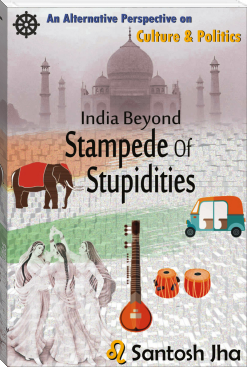Inane Interpolations In Bhagvad-Gita by BS Murthy (pdf to ebook reader .TXT) 📕

- Author: BS Murthy
Book online «Inane Interpolations In Bhagvad-Gita by BS Murthy (pdf to ebook reader .TXT) 📕». Author BS Murthy
Inane Interpolations
In Bhagvad-Gita
(An Invocation for their Revocation)
BS Murthy
Copyright@2021BS Murthy
Cover Concept – E. Rohini Kumar
Illustration Within – Gopi Lagusani
F-9, 1-10-234, Ashok Nagar,
Hyderabad – 500 020 (India)
Other books by BS Murthy –
Benign Flame: Saga of Love
Jewel-less Crown: Saga of Life
Crossing the Mirage – Passing through youth
Glaring Shadow - A stream of consciousness novel
Prey on the Prowl – A Crime Novel
Of No Avail – Web of Wedlock (A novella)
Stories Varied - A Book of short Stories
Onto the Stage – Slighted Souls and other stage and radio plays
Puppets of Faith: Theory of Communal Strife
Bhagvad -Gita: Treatise of Self –help (A translation in verses)
Sundara Kānda - Hanuman’s Odyssey (A translation in verses)
Dedicated to the slighted castes, whose forebear, Krishna, bestowed the invaluable Gita upon the mankind that in due course was fouled by the vested priestly interests.
Contents
Author’s Note
Gita’s Double Jeopardy
Provocation for Interpolation
Hindu Intellectual Apathy
Chapter - 3: Karma Yoga
Chapter - 4: Jñāna–Karma-SanyasaYoga
Chapter - 5: Karma–Sanyasa Yoga
Chapter - 6: Ātma Samyama Yoga
Chapter - 7: Gjnāna Vigjnāna Yoga
Chapter - 8: Akshara Parabrahma Yoga
Chapter - 9: Raja–Vidya–Raja–Guhya Yoga
Chapter - 11: Vishvarupa-sandarsanaYoga
Chapter -13: Kshetra–Kshetragjna Vibhāga Yoga
Chapter -14: Gunatraya–Vibhaga yoga
Chapter -15: Purushottama Prāpti Yoga
Chapter -16: Daivasura–Sampad–Vibhaga Yoga
Chapter- 17: Shraddhatraya-Vibhaga Yoga
Chapter -18: Moksha–Sanyasa Yoga
Author’s Note
When it comes to my tryst with Bhagvad-Gita, I may say that one thing led to the other, but with a difference – I can share the details with the public in this invocation for the revocation of its inane interpolations from it.
When I was around twelve, my paternal grandfather encouraged me to read the Gita even as he discouraged my mother from venturing into it, voicing the then prevailing view that if women were to imbibe its philosophy, then that could undermine their emotive self in the family fold. Given the lower levels of child awareness in those village days, comparatively speaking that is, as I could neither share Arjuna’s concerns nor grasp Krishna’s response, my first brush with the Gita ended before the end of its second chapter.
However, over two score years later, as it happened, it was a human tragedy that occasioned my fortuitous reengagement with the Gita, eventually that was, as, in the wake of the 2002 Godhra-Gujarat riots, the Op-eds in the print and the debates in the idiot box exhibited the vacuity of the Indian intelligentsia. As that laid the seeds of my Puppets of Faith: Theory of Communal Strife that sought to explore the role, if any, the religions play in fomenting communal discord, and if so, in which way, which in turn compelled me to seek out the Gita that is after perusing the Semitic scriptures. When I could see that apart from sharing the highway of devotion to the God with the Torah, the Bible, and the Quran for salvation, the Gita showed a subway of devotion to Duty leading up to moksha, I found it fascinating as by disposition I am not faith-inclined for it is not a handmaiden of reason.
It’s thus, after the completion of that critical appraisal of the Islamic faith, Indian polity ‘n more, for which I transcreated some selected Sanskrit slokas of the Gita into English verses that I set out to go the whole hog for its wholesome fare. Though Glaring Shadow was in wait to come into the light for by then I had done the novelling of Benign Flame, Jewel-less Crown and Crossing the Mirage, yet this epic pulled me onto its translative course. However, when I checked out of its third post, its route diversion from the set course that I came across perplexed me no end, but nevertheless as I persevered, to my utter dismay, its sectarian pattern became increasingly apparent. Then as it dawned on me that the epic is not to be taken at its face value and it is worth subjecting it to some form of scrutiny, so I looked around for precedents for guidance, but found none save Sir Edwin Arnold’s dismissal of slokas 23 thru 28 of its eighth chapter for they imply that “if one dies when the moon is on the ascent he would be heaven bound and, to hell if it’s other way round”, as the ranting of some vedānti.
It’s thus, I ploughed my lonely furrow in the Gita’s contaminated field and in the end could manage, needless to say with great effort, to ferret out 110 inane embedments, some of which have long been the impediments to the spiritual and social amity of the Hindu polity. So, I could visualize a social purpose in going public with my discoveries through Bhagvad-Gita: Treatise of Self-help, and thanks to Michael S. Hart, it first appeared in the public domain as free eBook at Project Gutenberg Self-Publishing Press only to make its way into umpteen literary websites thereafter. It’s no less heartening that Mike Stickles has accorded the pride of place to my work among the Gita’s translations at the Great Books and Classics site, and what is more, slowly but steadily it has been gaining ground in the web world, that too to some acclaim.
Though not resting on its laurels for I was engaged in creating seven more books in varied genres, including the translation of Sundara Kānda, of Ramayana, the foremost poetic composition in the world of letters, as Hanuman’s Odyssey, in English verses, and lo, its author, Sage Valmiki, was a Shudra that the ‘in vogue’ Gita belittles! Whatever, I left the Gita at that, but not before supplementing its eBook with a demonstrative audio rendition, also in the public domain. However, owing to its philosophical imprint that got etched in my mind, all along, I have been able to fend for myself through the lows of life without seeking His succor and support.
Now, eighteen years later, fortuitously yet again, my childhood artist friend, E. Rohini Kumar, who saw my Bhagvad-Gita: Treatise of Self-help, sans 110 inane interpolations, that carried only the rest of its ‘original’ verses, as an unfinished work, goaded me to place those inanities in the public domain for a reasoned review with a rational outlook. However, it is his hunch that the ‘overdue’ work, might lead the denied castes as well as the favoured folks for an objective approach to Gita ‘as it is’ which could dispel the misgivings of the former and the delusions of the latter that clinched the issue. Thus, serving the sore social need of bridging the Hindu emotional gulf with an abridged Gita that restores its original form owes to him for having conceptualized this Inane Interpolations in Bhagvad-Gita - An Invocation for their Revocation for which he conceived the cover as well, like he did for my earlier books, and now that women too have a free rein on this masterpiece, it is hoped that the propositions herein could be well-received, if not readily, maybe in times to come
Gita’s Double Jeopardy
Bhagvad-Gita, often referred to as the Gita, comprises eighteen chapters, which, in all, contain seven hundred slokas (verses) that is not counting the unnumbered opening number of its thirteenth chapter. Though it has gained prominence on its own steam, in fact it is a part of the epochal Mahabharata, which, with over 100,000 slokas, is the longest tome in the world of letters. Moreover, this epic, probably compiled around the third century BCE, whose authorship is attributed to Vyāsa, is regarded by the Hindus as the panchama veda (the fifth Veda) and the Gita, its divine part, is celebrated by the world as an unrivalled philosophical work.
Yet it is a safe bet to aver that while most (mainly Hindus) might have heard about it, hardly any would have read it (much less appraised it) though it contains no more than seven-hundred verses, excluding the above cited unnumbered one! Not only that, possibly, this classic could be the only epic in the world that is admired without application of mind and debunked with reasonable misgivings as it, as it is, sanctions the inimical caste structure in the Hindu polity that is as opposed to the Torah, the Bible, and the Quran, which seek to inculcate emotional unity amongst their respective adherents!
Whatever, on one hand, William von Humboldt, the philosopher of yore, eulogized it as “the most beautiful, perhaps the only true philosophical song existing in any known tongue …. perhaps the deepest and the loftiest thing the world has to show”, and on the other, Vijay Mankar, the Ambedkarite of the day, debunks it is as a rotten work deserving to be thrown into a dustbin for “it advocates inequality of man based on caste, stigmatizes women as an inferior kind, and legitimizes violence.” Equally significantly, neither Humboldt was alone in lifting it to the skies for he had the illustrious company of many a Western thinker such as Arthur Schopenhauer, Albert Einstein, Aldous Huxley, Henry David Thoreau, Ralph Waldo Emerson, only to name a few, nor Mankar lacked company to castigate it as a book of bigotry, for Ambedkar the Dalit intellectual colossus, who piloted the Indian Constitution, was unsparing about it.
It is possible that the Western intellectuals, who could have internalized the Semitic religious notion of the Lord God’s alleged partiality towards his chosen peoples, might have seen nothing perverse in Krishna’s creation of the caste inequity in the Hindu spcial fold sanctified in the Gita thus:
Ch4, V13
chātur-varṇyaṁ mayā sṛiṣhṭaṁ guṇa-karma-vibhāgaśhaḥ
tasya kartāram api māṁ viddhyakartāram avyayam
It is I who engineered the division of men into four varna (castes) based on their guna (innate nature) and karma (earthly duties) but yet although I am the creator of this system, know me to be the non-doer and eternal,
Or, maybe, they would have simply concerned themselves with its fascinating philosophical postulations, bypassing its alleged espousal of the caste inequities in an alien polity the nuances of which they were unfamiliar with.
However, in contrast, the improbability of their progenitor Krishna, the architect of the Gita, relegating his own ilk to the social margins failed to dawn upon the Shudras that it supposedly slights, even to this day! Thus, their intellectuals, instead of seeking to reclaim their priceless heritage, albeit after ridding its interpolative garbage, tend to rubbish it a la throwing the baby with the bathwater.
Well, if only they apply their mind, bearing Krishna’s advice to Arjuna in mind,
Ch18, V63
That thee heard of this wisdom
For task on hand now apply mind
iti te jñānam ākhyātaṁ guhyād guhyataraṁ mayā
vimṛiśhyaitad aśheṣheṇa yathechchhasi tathā kuru,
then, it would be apparent to them that their ancestral work was infested with umpteen interpolations that sanctify their social inferiority and further the Brahmanical religious interests, which together muddy its pristine philosophy besides affecting the sequential conformity and structural economy.
However, to be able to discern the Gita in proper perspective, and to be able to visualize its fouling interpolations, one must appreciate its context in the epic of Mahabharata that is at the threshold of the battle royale between the estranged cousins, Pandavas ‘n Kauravas, when Arjuna, the spearhead of the former, suffers from qualms about the prospect of slaying his kith and kin for power and pelf.
In this urge to usher in Gita’s votaries, as well as the sideliners, into its ancient granary so as to enable them to segregate its grain from the interpolative chaff, the quotes in verses are excerpted from the author’s eBook, Bhagvad-Gita: Treatise of Self-help, which, as already stated, is in the public domain, and the interpolations (in boxes) are obtained from other sources, however, in both cases with the Sanskrit slokas of the in vogue text.
Ch1, V28
Thus spoke Arjuna:
Disturb kinsfolk here gathered
Feel I parched, it nauseates too.
dṛiṣhṭvemaṁ sva-janaṁ kṛiṣhṇa yuyutsuṁ samupasthitam
sīdanti mama gātrāṇi mukhaṁ cha pariśhuṣhyati
Ch1, V37
See I no gain by their end
Why then kill our kith





Comments (0)